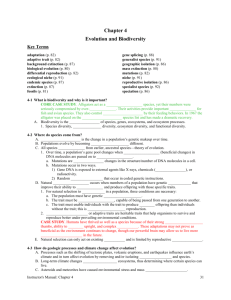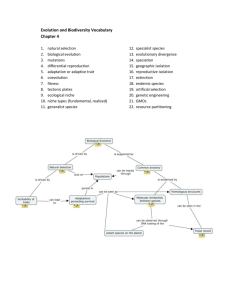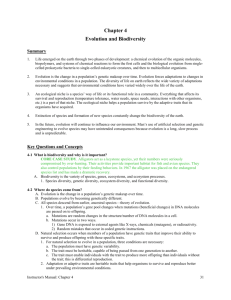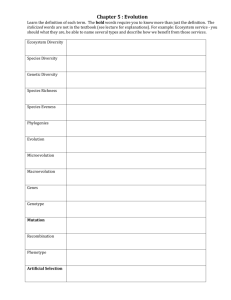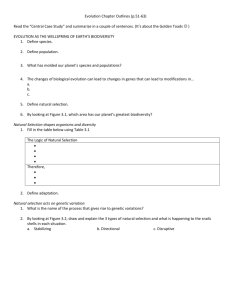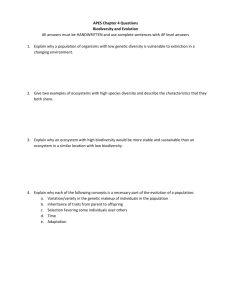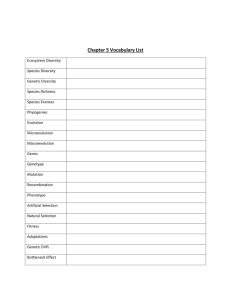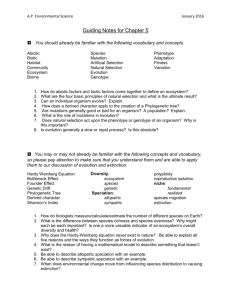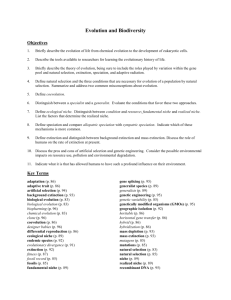Chapter 4 - Fort Bend ISD / Homepage
advertisement
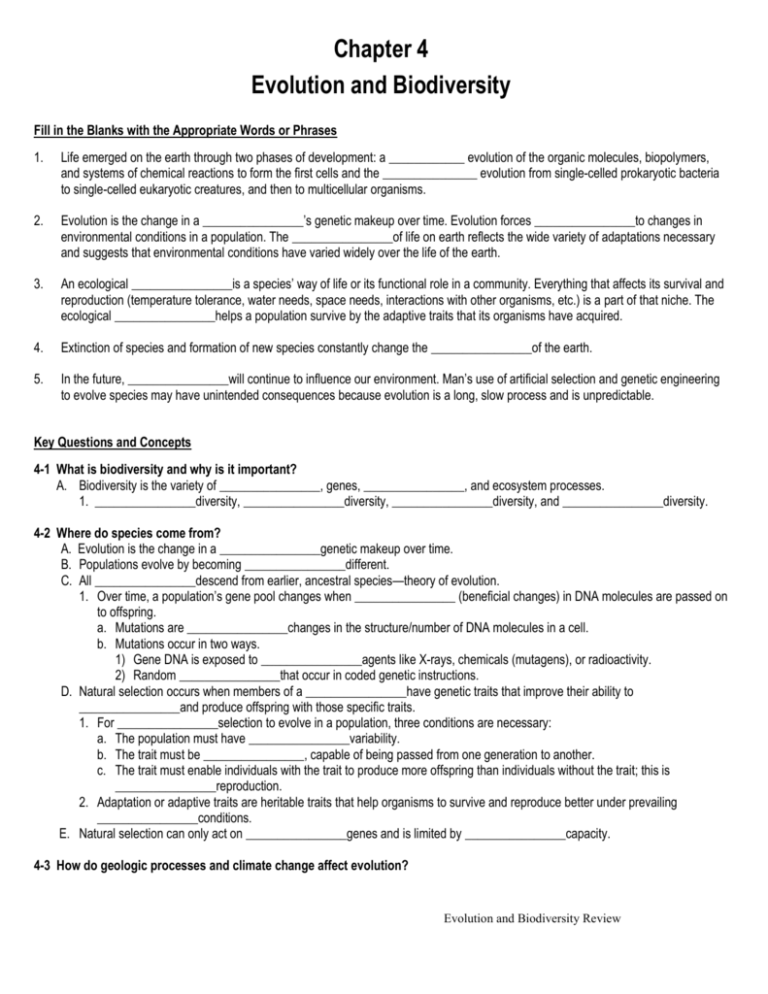
Chapter 4 Evolution and Biodiversity Fill in the Blanks with the Appropriate Words or Phrases 1. Life emerged on the earth through two phases of development: a ____________ evolution of the organic molecules, biopolymers, and systems of chemical reactions to form the first cells and the _______________ evolution from single-celled prokaryotic bacteria to single-celled eukaryotic creatures, and then to multicellular organisms. 2. Evolution is the change in a ________________’s genetic makeup over time. Evolution forces ________________to changes in environmental conditions in a population. The ________________of life on earth reflects the wide variety of adaptations necessary and suggests that environmental conditions have varied widely over the life of the earth. 3. An ecological ________________is a species’ way of life or its functional role in a community. Everything that affects its survival and reproduction (temperature tolerance, water needs, space needs, interactions with other organisms, etc.) is a part of that niche. The ecological ________________helps a population survive by the adaptive traits that its organisms have acquired. 4. Extinction of species and formation of new species constantly change the ________________of the earth. 5. In the future, ________________will continue to influence our environment. Man’s use of artificial selection and genetic engineering to evolve species may have unintended consequences because evolution is a long, slow process and is unpredictable. Key Questions and Concepts 4-1 What is biodiversity and why is it important? A. Biodiversity is the variety of ________________, genes, ________________, and ecosystem processes. 1. ________________diversity, ________________diversity, ________________diversity, and ________________diversity. 4-2 Where do species come from? A. Evolution is the change in a ________________genetic makeup over time. B. Populations evolve by becoming ________________different. C. All ________________descend from earlier, ancestral species—theory of evolution. 1. Over time, a population’s gene pool changes when ________________ (beneficial changes) in DNA molecules are passed on to offspring. a. Mutations are ________________changes in the structure/number of DNA molecules in a cell. b. Mutations occur in two ways. 1) Gene DNA is exposed to ________________agents like X-rays, chemicals (mutagens), or radioactivity. 2) Random ________________that occur in coded genetic instructions. D. Natural selection occurs when members of a ________________have genetic traits that improve their ability to ________________and produce offspring with those specific traits. 1. For ________________selection to evolve in a population, three conditions are necessary: a. The population must have ________________variability. b. The trait must be ________________, capable of being passed from one generation to another. c. The trait must enable individuals with the trait to produce more offspring than individuals without the trait; this is ________________reproduction. 2. Adaptation or adaptive traits are heritable traits that help organisms to survive and reproduce better under prevailing ________________conditions. E. Natural selection can only act on ________________genes and is limited by ________________capacity. 4-3 How do geologic processes and climate change affect evolution? Evolution and Biodiversity Review A. Processes such as the shifting of ________________plates, ________________eruptions, and earthquakes influence earth’s climate and in turn affect evolution by removing and/or isolating habitats and species. B. Long-term ________________changes relocate ecosystems, thus determining where certain species can live. C. ________________and meteorites have caused environmental stress and mass extinctions. 4-4 How do speciation, extinction, and human activities affect biodiversity? A. Natural selection can lead to ________________of an entirely new species. In speciation, ________________species arise from ________________when some members of a population cannot breed with other members to produce fertile offspring. Speciation occurs in two phases: 1. ________________isolation, physical separation for long time periods. 2. ________________isolation. B. When population members cannot adapt to ________________environmental conditions, the species becomes ________________. C. When local environmental conditions change, some species will disappear at a ________________rate; this is called background extinction. D. ________________extinction is a significant rise in extinction rates above the background extinction level. Usually, ________________% of species are lost. 4-5 What is species diversity and why is it important? A. Species diversity is the number of species (________________) combined with their relative abundance (________________). B. Species rich communities tend to be more ________________and more productive. 4-6 What roles do species play in ecosystems? A. Ecological niche is a species’ way of ________________in an ecosystem, everything that affects its survival and reproduction. 1. The niche includes the members’ ________________; its range of ________________for physical and chemical conditions, its ________________with other components of the ecosystem, and its ________________in energy flow and matter recycling. 2. The fundamental niche is the full ________________range of conditions and resources a species could potentially use. Its realized niche is the part of the potential niche that allows a species to survive and avoid ________________with other species for the same resources. B. Some species have ________________ecological roles and are termed generalist species. C. Some species have ________________ecological roles and are termed specialist species. D. Niches can be occupied by ________________or non-________________species. E. ________________species provide early warning of ecosystem damage because they have a narrow range of tolerance. H. Keystone species have a large affect on maintaining ________________within an ecosystem. 1. Can be, but are not necessarily, ________________and top ________________. 2. Foundation species create and ________________habitats that benefit other species. Key Terms adaptation (p. 82) adaptive trait (p. 82) background extinction (p. 87) biological evolution (p. 80) differential reproduction (p. 82) ecological niche (p. 91) endemic species (p. 87) extinction (p. 87) fossils (p. 81) gene splicing (p. 88) generalist species (p. 91) geographic isolation (p. 86) mass extinction (p. 88) mutations (p. 82) niche (p. 91) reproductive isolation (p. 86) specialist species (p. 92) speciation (p. 86) Evolution and Biodiversity Review
